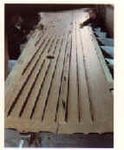A colleague at work told me that the P-51 had a thick aluminum skin and that
this thick skin allowed the engineers to use less structural reinforcing members in the frame. He said that the P-51's skin, for instance, was thicker than the P-47's and that as a result, the P-47 required more structural bracing.
On a somewhat related note, I understand that the P-51, aka, the "Spam Can" was rather flimsy and read that one pilot that flew both the P-47 and P-51 said that the P-47 was built like a machined tool while the P-51 had a cheaper, stamped construction.
this thick skin allowed the engineers to use less structural reinforcing members in the frame. He said that the P-51's skin, for instance, was thicker than the P-47's and that as a result, the P-47 required more structural bracing.
On a somewhat related note, I understand that the P-51, aka, the "Spam Can" was rather flimsy and read that one pilot that flew both the P-47 and P-51 said that the P-47 was built like a machined tool while the P-51 had a cheaper, stamped construction.














